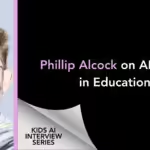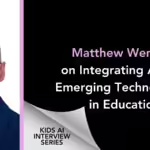Phillip Alcock on AI’s Role in Education
-
October 3, 2025 - 4 min read

-
October 3, 2025 - 4 min read
In another enlightening chapter of our KidsAI Interview Series, we examine the visionary work of Phillip Alcock, an innovative educator melding Artificial Intelligence (AI) with Project-Based Learning (PBL) to revolutionize classrooms. A staunch advocate for ethical AI use in education, Phillip brings his diverse experiences and rich cultural insights to the forefront, illuminating the path to an inclusive and responsible learning environment. He shares compelling personal narratives and pragmatic strategies that underscore the necessity of teacher and student involvement in the deployment of AI tools. Phillip’s expertise and forward-thinking approach offer invaluable guidance for educators and policymakers navigating the dynamic confluence of technology and education.
Kids AI: Phillip, your journey is a testament to the power of integrating AI within diverse educational contexts. How do your experiences align with the mission of promoting ethical and responsible AI use in education?
Thank you. As a kid in a lower socio-economic neighbourhood in Australia, and attending low-funded public schools, I saw first-hand how a lack of tech resources can put students at a disadvantage. That experience ignited my passion for using technology to bridge educational divides. My journey – spanning Australia, Asia, and Central America, as well as varied roles in education, IT, and business – has shaped my belief that for AI to be truly transformative in education, it must be designed with inclusivity and ethics at its core.
Take my time in Darwin, facing some of Australia’s lowest digital literacy rates. Rather than seeing technology as a replacement for teachers, I used project-based learning to transform their perspective – technology became a powerful tool in their hands. This human-centred approach is essential when integrating AI as well.
Here’s how my experiences align with the mission of promoting ethical and responsible AI use in education:
- Prioritising Human-Centered Design: Teachers must be integral in designing and implementing AI. Their insights ensure it complements existing methods and addresses students’ diverse needs. Project-based learning allows for this collaborative leadership.
- Mitigating Bias: Algorithms need constant monitoring to identify and root out biases. AI must work for all students, regardless of background. My cross-cultural work highlights the importance of this vigilance.
- Cultivating Transparency: Openness about how AI is used builds trust with students, teachers, and parents.
- Fostering Digital & AI Literacy: Students need the technical skills and the critical thinking to navigate an AI-influenced world ethically.
I believe that by carefully designing AI frameworks that empower both teachers and students, we can create learning environments where technology is a force for good. This includes rigorous testing of systems to ensure they serve everyone equitably.
Kids AI: In crafting AI-enhanced PBL (Project-Based Learning) units, how do you ensure these tools are not only engaging but also safe and transparent for student interaction?
Crafting engaging, safe, and transparent AI-enhanced PBL units requires a thoughtful, multi-faceted approach:
Engagement
- Student Agency: Prioritise AI tools that empower students to take ownership of their learning journey. This includes tools for self-directed inquiry, personalised project pathways, and AI-powered feedback that promotes reflection and iteration.
- Real-World Relevance: Connect PBL units to authentic problems and scenarios students care about. AI can help source relevant datasets, simulate real-world challenges, and connect students with experts in the field, leading to more meaningful work.
- Collaboration: Foster student collaboration using AI to power peer feedback mechanisms, facilitate knowledge sharing and create opportunities for collective problem-solving.
Safety
- Proactive Moderation: A combination of robust AI-powered content filtering, human oversight, and established community guidelines are essential to creating safe learning environments.
- Age-Appropriate Tools: Curate AI tools specifically designed with the developmental needs and safety of your student population in mind.
- Digital Citizenship: Weave lessons on responsible online behaviour, cyberbullying prevention, and critical evaluation of AI-generated content directly into the PBL experience.
Transparency
- Openness About AI: Demystify how the AI tools function with age-appropriate explanations. Encourage students to think critically about the potential biases and limitations of these technologies.
- Focus on Skills: Emphasize that AI tools are designed to augment human thinking, not replace it. Teach students how to effectively leverage AI alongside their own creativity, problem-solving abilities, and critical reasoning.
- Student Voice: Empower students to participate in the evaluation and selection of AI tools for their learning experiences.
Additional Considerations
- Accessibility: Prioritise AI solutions that cater to diverse learning needs and varying levels of tech access. Include offline alternatives, adaptive technologies, and options for low-bandwidth environments.
- Educator Support: Provide ongoing professional development for educators on the ethical use of AI, pedagogical strategies for AI-enhanced PBL, and tools for navigating potential challenges.
By addressing engagement, safety, and transparency holistically, you can harness the transformative potential of AI while fostering responsible, empowered learners.
KidsAI Closing Insights
In our inspiring dialogue with Phillip Alcock, we’ve delved into the dynamic intersection of AI and Project-Based Learning (PBL), guided by a vision of accessible, equitable education. Phillip’s emphasis on ethical AI integration, collaborative design, and learner empowerment shines a light on the transformative impact AI can have when grounded in human-centered values. His cross-cultural experience and dedication to inclusivity help forge educational tools that are as diverse as the students they serve. Phillip’s commitment to enhancing educational experiences through technology while maintaining a focus on the principles of responsibility, transparency, and inclusivity stands as a model for educators worldwide. As we continue to integrate AI into learning environments, Phillip Alcock’s insights encourage us to build a future where technology uplifts every learner, fostering a global community of critical thinkers and innovators.





